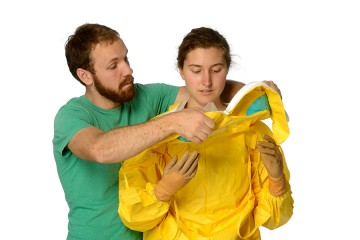When asking students about their top 10 places to visit, Liberia isn't a country that you hear often. However, for recent Johns Hopkins University graduate Laura Scavo, it was on the top of her list.

Image caption: From left to right: Colby Wilkason, product development manager for Ebola PPE project; Laura Scavo, technical lead on face mask development; Chandrakant Ruparelia, senior technical advisor at Jhpiego; and Patience Osei, product development manager for Ebola PPE.
Liberia was of particular interest to Scavo because of its recent outbreak of the Ebola virus. During her last semester as a mechanical engineering major this past spring, Scavo collaborated with the [Johns Hopkins Center for Bioengineering Innovation & Design](http://cbid.bme.jhu.edu) (CBID) to redesign the hood and mask portion of their newly designed Ebola protective suit. The end goal of the redesign was to make breathing easier for the user while maintaining increased visibility, lowering fogging, and making it easier and safer to remove. But a simple redesign wasn't enough for Laura—she wanted to travel to Liberia and see her work in action.
So she did. Along with other representatives from or CBID—a center in the Department of Biomedical Engineering shared by the university's Whiting School of Engineering and School of Medicine—and Jhpiego, a university affiliate, Scavo traveled to Liberia and conducted usability studies of personal protective equipment for health care workers treating Ebola and other infectious diseases.
"It was an amazing trip—I was able to watch end users interact with a product I helped design and get their feedback on it," Scavo said. "Liberian health care workers who were on the front lines during the 2014 Ebola outbreak participated in the study, providing feedback on how our designs compare to what they wore in the field."
While many changes were made to the original CBID design, Scavo's main alterations involved redesigning the face mask in order to provide a better fit for a wide range of face sizes, and adjusting filter placements so that the design would meet product requirements.
Scavo's collaboration with CBID allowed her to develop testing prototypes that may be mass-produced under an agreement forged last year between Johns Hopkins and DuPont, an international leader in personal protective equipment.
"Having Laura on our team brought skills from another leading design program in the Whiting School, Mechanical Engineering, to the project," says Youseph Yazdi, CBID's executive director and biomedical engineering faculty member. "Laura represented the program well and has encouraged us to build strong ties to Mechanical Engineering and other design programs within the Whiting School."
Posted in Health, Student Life
Tagged global health, epidemiology, jhpiego, undergraduate research, ebola, cbid










